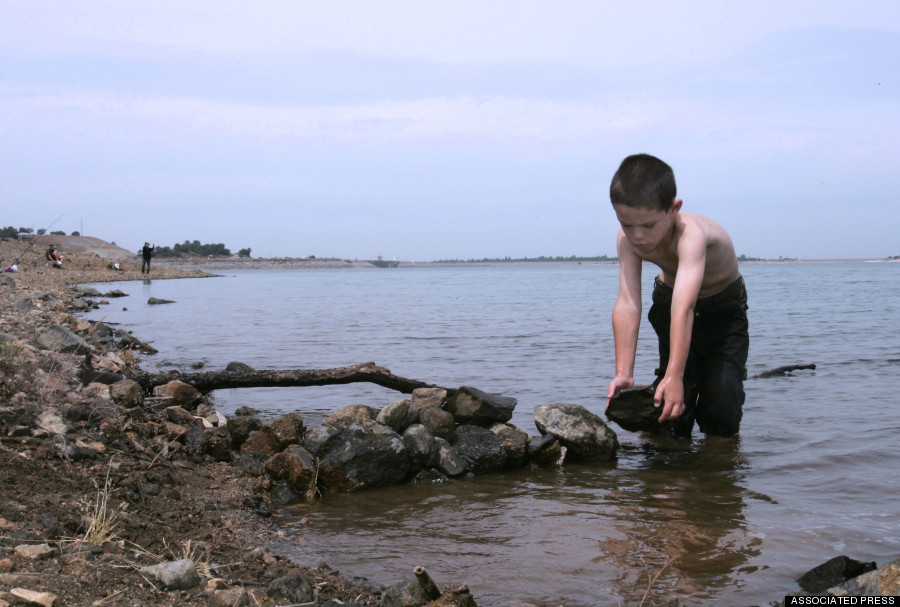Kathleen Miles is the executive editor and cofounder of Noema Magazine. She can be reached on Twitter at @mileskathleen.
California is dry as a bone, and the effects are like something out of an apocalyptic film.
Cities are running out of water. Communities are fighting over what little water there is. Local governments are imposing rationing coupled with steep fines. Fires are ravaging the state. Entire species and industries are threatened.
For California, 2013 was the driest year since the state started measuring rainfall in 1849. Paleoclimatologist B. Lynn Ingram says that, according to the width of old tree rings, California hasn’t been this dry for about 500 years.
Gov. Jerry Brown has declared an emergency, President Barack Obama has pledged his support, and state and federal officials are stepping in to protect the state’s most vulnerable groups. Californians of various faiths have taken to holding prayer sessions, looking to the heavens for rain. Here are some of the drought’s effects so far.
Running Out Of Drinking Water Seventeen rural communities in California are in danger of running out of water within 60 to 120 days, according to a list compiled by state officials. As the drought goes on, more communities are likely to be added to the list.
Seventeen rural communities in California are in danger of running out of water within 60 to 120 days, according to a list compiled by state officials. As the drought goes on, more communities are likely to be added to the list.
With only about seven inches of rain in California in 2013 — far below the average of 22 inches — wells are running dry and many reservoirs are about 30 percent full (including Folsom Lake, shown above).
The Sierra snowpack, where California gets about a third of its water, was 88 percent below average as of Jan. 30. Some are concerned that the diminished snowmelt is causing more pumping of contaminated groundwater, particularly in disadvantaged areas such as California’s San Joaquin Valley.
Food Supply Threatened California’s $45 billion agriculture business accounts for 15 percent of U.S. crop sales. But this year, farmers fear they may lose their entire crops. That could cause food prices to go up for most Americans. Some farmers are paying the expensive price of scarce water to irrigate crops. Others, unable to afford water, have been forced to leave fields fallow.
California’s $45 billion agriculture business accounts for 15 percent of U.S. crop sales. But this year, farmers fear they may lose their entire crops. That could cause food prices to go up for most Americans. Some farmers are paying the expensive price of scarce water to irrigate crops. Others, unable to afford water, have been forced to leave fields fallow.
Ranchers are struggling to feed livestock, as there is much less grass. Some have been paying more for alternative feed. Others have had to sell portions of their herd. In California’s vineyard capital, Napa Valley, wine grape growers said some vines are ripening early. Farmers are planning fewer crops to save water.
Fires Of Unprecedented Number And Size Drought and a warming climate has left California particularly vulnerable to wildfires. From Jan. 1 to Jan. 25, state firefighters responded to 406 wildfires. During the same period last January, there were none, and the historic average is 69.
Drought and a warming climate has left California particularly vulnerable to wildfires. From Jan. 1 to Jan. 25, state firefighters responded to 406 wildfires. During the same period last January, there were none, and the historic average is 69.
The Colby fire in the LA-area earlier this month is evidence of the danger. The fire spread rapidly and charred five homes, 17 other structures and about three square miles of land.
In August, the Rim Fire (pictured above) ravaged Yosemite National Park, leaving a barren moonscape that researchers say is larger than any burned area since the Little Ice Age, which began in 1350.
Conflict Over What Little Water There Is California’s water wars between Los Angeles and farmers in eastern California were famously depicted in the 1974 film “Chinatown.” Nearly a century after the initial conflict, the water wars are not over.
California’s water wars between Los Angeles and farmers in eastern California were famously depicted in the 1974 film “Chinatown.” Nearly a century after the initial conflict, the water wars are not over.
For years, signs along Central California fields reading “Congress-created dustbowl” and “man-made drought” have reflected an ongoing battle between farmers and environmentalists over water from a large estuary northeast of the San Francisco Bay called the Sacramento-San Joaquin Delta. Three million acres of farmland and 25 million people from San Jose to San Diego depend on water from the delta, but environmental regulations to protect threatened delta smelt and endangered salmon have restricted the amount of water that can be pumped from it.
With the drought in full force, House Speaker John Boehner (R-Ohio) and three Republican congressmen from Central California proposed emergency drought legislation to allow farmers to pump irrigation water from the protected delta. Their effort was unsuccessful, but they have vowed to try again. In addition, the governor, in conjunction with state agencies, has proposed a plan that would cost from $25 billion to as much as $67 billion to build two 30-mile underground tunnels to ensure water delivery from Northern California to Southern California.
Environmentalists vehemently oppose both propositions, arguing they will destroy the delta’s ecosystem. Instead, they say governments should legislate efforts to capture more rain and conserve and recycle water (which Brown hasn’t mandated, but is encouraging).
While farmers fight to water their land and environmentalists fight to protect ecosystems, social activists are advocating for disadvantaged communities in parts of the state where low-income minorities have poor quality drinking water. Furthermore, as farmers and ranchers cut back, their employees, who are predominantly Latino, lose jobs.
Water Rations And Steep Fines Brown has called for a 20 percent voluntary reduction in water use for all Californians “in both rural areas and cities.” But more and more cities are mandating it, particularly in Northern California.
Brown has called for a 20 percent voluntary reduction in water use for all Californians “in both rural areas and cities.” But more and more cities are mandating it, particularly in Northern California.
Sacramento and Folsom have mandated a 20 percent reduction for all residents and businesses. Sacramento has stepped up enforcement of restrictions on watering lawns by time of day and day of week, with fines up to $1,000.
Santa Cruz has banned restaurants from providing customers with drinking water unless it is requested and has forbidden the filling of newly installed swimming pools. Willits, a town of 5,000 in Mendocino County, has adopted rationing that limits a family of four to 150 gallons of water a day and bans outdoor watering and hosing down pavement. Marin County has asked residents to not clean their cars or to do so only at eco-friendly car washes. Other counties have imposed similar restrictions.
Parks, Species And Tourism Threatened California has a large ski industry, but this year, there’s hardly any snow. Nearly all the snow at major resorts in Lake Tahoe, Mammoth and other parts of the Sierra Nevada mountains this month was made with expensive snow-making machines. If it wasn’t for the machines, which require a lot of water and compressed air, the resorts would probably have to close. Many small, family-owned resorts have already shut. Yosemite National Park, which normally attracts skiers this time of year, is offering summer-like hikes and horseback riding instead.
California has a large ski industry, but this year, there’s hardly any snow. Nearly all the snow at major resorts in Lake Tahoe, Mammoth and other parts of the Sierra Nevada mountains this month was made with expensive snow-making machines. If it wasn’t for the machines, which require a lot of water and compressed air, the resorts would probably have to close. Many small, family-owned resorts have already shut. Yosemite National Park, which normally attracts skiers this time of year, is offering summer-like hikes and horseback riding instead.
California wildlife officials have banned fishing in several rivers, including the San Lorenzo River, the Big Sur River and the Pescadero Creek, to protect salmon and steelhead trout. The fish are in danger as low water levels in many rivers may prevent them from migrating and spawning. In cities and towns surrounding the Sierra Nevadas, there have been increased sightings of bears, possibly because the drought cuts down on bears’ food sources.
In Southern California, the iconic Joshua Trees of Joshua Tree National Park recently produced larger flowers than residents have ever seen, possibly because of a biological urge to produce more seeds to survive with less rain. While the huge blooms were beautiful, they’re a sign that the trees, which have been in decline, are struggling to survive.
Scientists project that extremely dry conditions will continue in the future due to climate change. Researchers later this year will examine how much of this recent California drought can be blamed on human-caused climate change.



